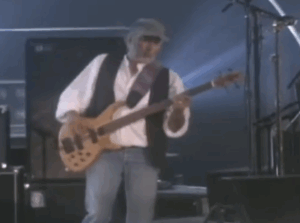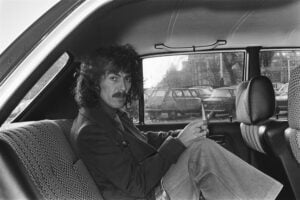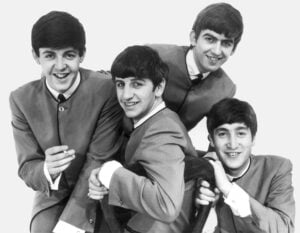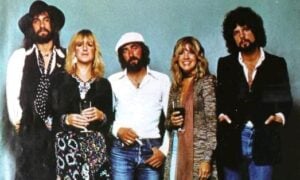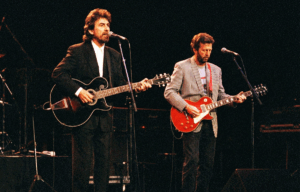From Eccentric to Outright Strange: The Weirdest Personalities in ’80s Music

LOS ANGELES - MARCH 19: Musician Prince performs onstage at the 36th Annual NAACP Image Awards at the Dorothy Chandler Pavilion on March 19, 2005 in Los Angeles, California. (Photo by Kevin Winter/Getty Images)
Some music stars are just plain eccentric—call it artistic flair, call it fame getting to their heads, or maybe it’s a side effect of all that creative energy. Whatever the reason, the ’80s delivered a goldmine of musical weirdness. Maybe it was the neon, the synths, or the rise of MTV, but that decade had more than its share of eyebrow-raising behavior.
From bizarre interviews to cringey live performances and wild fashion choices, some of the biggest names in ’80s music were just as famous for their quirks as their hits. Whether it was genius, chaos, or a little of both, here are the weirdest icons from the wonderfully strange “Decade of Excess.”
Gary Numan
Gary Numan made a big splash on the U.K. charts in 1979 with Tubeway Army’s “Are ‘Friends’ Electric?” but it was his 1980 hit “Cars” that made him a household name, especially in the U.S., where it climbed into the Top 10. You’d think two major hits in under a year would turn any 20-something into a rock star bursting with confidence—but Numan was the opposite. Despite his fame, he struggled with crippling shyness and stage fright.
To cope, Numan created a futuristic, robotic persona—cool, distant, and a little alien. It wasn’t just a style choice; it was a shield. “The whole image was my way of getting around the fact I was cripplingly shy,” he told The Guardian in 2013. That carefully crafted image is front and center in the video for “Cars,” which features him alone, sealed off, and singing lyrics like, “Here in my car, I feel safest of all.” Over time, though, Numan found his footing. “I used that persona long enough that it enabled me to feel natural,” he said. “Then I didn’t need it anymore.”
Rockwell
If the name “Rockwell” makes you picture a nervous guy hiding behind the curtains, you’re not alone. Most people remember him for his 1984 hit “Somebody’s Watching Me”—a paranoia-fueled anthem featuring a little help from Michael Jackson on the chorus. The song shot to No. 2 on the Billboard charts, and his follow-up single, “Obscene Phone Caller,” also crept into the Top 40. Sensing a theme? Rockwell basically cornered the market on what could be called “Paranoia Pop.”
But the man behind the music was just as quirky as his songs. Few fans knew at the time that Rockwell was actually the son of Motown founder Berry Gordy Jr. Even though he was signed to Motown, he landed the deal without his dad’s help—and went out of his way to prove it. To dodge claims of nepotism, Rockwell even faked a British accent in interviews and on the track itself. That strange voice you hear in “Somebody’s Watching Me”? Yep, it’s him doing his best (or weirdest) attempt at sounding like he’s from across the pond.
Prince
Prince was never exactly known for blending in. From his wild fashion to his rule-breaking music, the guy lived in his own universe—and proudly so. He was a devout Jehovah’s Witness who also happened to write some of the steamiest songs in pop history. And his obsession with the color purple? Legendary. He famously banned anyone—bandmates, backup singers, even openers—from wearing it onstage unless it was him.
But Prince’s quirks went way beyond wardrobe choices. He loved basketball (and was actually pretty good, despite being only 5’2″), ping pong, and roller skating. Questlove once shared a story about a Prince skate party where the star rolled in wearing glowing, crystal-clear skates that lit up and shot multicolored sparks behind him. Because of course he did.
Prince also claimed to basically never sleep, bragging in 1985 that no one could outlast him when it came to staying awake. Why? In his mind, time wasn’t even real. “Time is a mind construct,” he told The Guardian in 2011. “It’s not real.” Just like Prince himself—utterly one of a kind.
Michael Jackson
Everyone knows the late, great Michael Jackson had a flair for the unusual—you don’t build and live in your own private amusement park called Neverland if you’re going for subtle. But in the 1980s, his quirks reached a whole new level. Honestly, it’s a wonder he didn’t keep the tabloid industry afloat all by himself.
For starters, there were the pets—wild ones. Jackson had a chimp named Bubbles who went everywhere with him, even to the studio. Then there was Muscles, his giant boa constrictor, which sounds more like a cartoon character than a pet.
But it didn’t stop there. In the mid-’80s, he reportedly shelled out around $1 million to rent a hyperbaric oxygen chamber from a California hospital, because he believed it could help him live longer. He eventually bought it to use regularly.
And then there was his fascination with John Merrick, the “Elephant Man.” Jackson offered $1 million to buy Merrick’s remains from a London hospital. They declined—but it definitely added another chapter to MJ’s legacy of bizarre behavior.
Kate Bush
For years, Kate Bush was a bit of a mystery to most Americans—until her 1985 song “Running Up That Hill” suddenly exploded in 2022 thanks to Stranger Things. But long before she became a streaming sensation, Bush was already a music legend in the U.K. She’s eccentric, unapologetically British, and wildly talented. As a teen, she filled journals with poetry so advanced it impressed David Gilmour of Pink Floyd. He helped her record a professional demo, and she signed with EMI Records while still in high school.
Her first single, “Wuthering Heights,” was a soaring, theatrical retelling of the classic novel, sung in a one-of-a-kind, high-pitched warble. It hit No. 1 in the U.K. but left U.S. listeners more confused than captivated. Still, Bush leaned into her artistic quirks, releasing songs that were poetic, dramatic, and full of theatrical flair. While British fans embraced her, American audiences mostly scratched their heads. Before her recent chart comeback, her biggest U.S. hit was the 1987 duet with Peter Gabriel, “Don’t Give Up,” which peaked at No. 72—and featured a video of the two just hugging in slow motion.
Björk
Björk first stepped into the spotlight in the ’80s as the lead singer of the Sugarcubes, but she really made her mark as a solo artist. Known for her unique voice and experimental sound, she had a few hits on the U.S. charts and built a reputation for pushing musical boundaries. But let’s be honest—what most people remember just as much (if not more) is her wild, unpredictable fashion sense.
While many artists have flirted with eccentric outfits, Björk has lived there full-time. Over the years, she’s shown up in everything from jewel-encrusted face masks to pom-pom headdresses that completely swallowed her head. There was the concert where she looked like she was wrapped in doilies, the festival appearance in a “dress” made of shiny black tubes, and, of course, her infamous 2023 Tokyo concert look—basically an exploding, glittery Christmas tree covered in icy branches.
Back in 2006, a U.K. poll named her the most eccentric celebrity on the planet. Fast forward to today, and it’s safe to say she’s still holding that title—maybe even running unopposed.
David Byrne
Talking Heads, led by the wonderfully odd David Byrne, were arguably the quirkiest act to come out of the late ’70s New York punk scene—and that’s saying something. Unlike their CBGB peers, they didn’t snarl or shred. Instead, they showed up clean-cut, tight as a drum musically, and delivered a funky, offbeat sound that was anything but punk. Then there was Byrne himself, famously jittery and intense, once singing from the perspective of a serial killer mid-song… in French.
The band never fit neatly into any genre box, though critics tried with labels like “art rock” and “progressive funk.” Byrne, always a contradiction, didn’t help: a guy known for being emotionally reserved, yet he wrote heartfelt songs about love, babies, and joy. He seemed like the least likely frontman—and yet, onstage, he was electric.
If you want a snapshot of his unique weirdness, check out True Stories, the bizarre 1986 film he co-wrote and directed. Or just watch the “Once in a Lifetime” video, where he dances like a glitching preacher while sweating through an existential meltdown. Classic Byrne.
Brian Eno
Brian Eno started out as the synth wizard for Roxy Music, but he’s far better known today as one of the most creative producers in modern music. He’s the genius behind groundbreaking work with artists like David Bowie, U2, Talking Heads, and more. Eno doesn’t just polish up a band’s sound—he pulls out their strangest, boldest sides. That’s probably because his whole approach to music is, well, totally unique.
Eno doesn’t see any lines between art, science, or culture. To him, it’s all part of the same experiment. In a 1997 interview with Edge, he said, “There should be one language that fits [fashion, art, cake decoration] together… there is a deep connection between art and science. Each is a highly organized form of pretending.”
And he doesn’t just talk the talk. Look at his production credits: Bowie’s Heroes, Talking Heads’ Remain in Light, Devo’s Are We Not Men?, even the soundtrack for Dune. Eno’s not just a producer—he’s a one-man art lab disguised as a music nerd.
Kid Creole
If you hear the name Kid Creole and the Coconuts, you’re probably expecting something a little out there—and you’d be right. August “Kid Creole” Darnell fully embraced the eccentric. He built a wild, theatrical persona that blended dapper Zoot suits, wingtip shoes, and a musical style that mashed up disco, Caribbean rhythms, and big band swing. It was like Cab Calloway met Harry Belafonte at Studio 54. Backed by his backup singers (a.k.a. “the Coconuts,” known for their cheeky stage presence), Darnell scored a string of U.K. hits like “Annie, I’m Not Your Daddy,” “Don’t Take My Coconuts,” and “The Lifeboat Party.”
In a 1981 New York Times interview, Darnell described his album Fresh Fruit in Foreign Places as a musical journey—part autobiographical, part cultural mashup. “It explains how the music came to be the music that it is,” he said. Decades later, he told The Guardian the whole act was satire. “We frowned on the idea of the elegant elite… then we became the thing we made fun of.” Spoken like a true showman with a master’s degree in English.
Malcolm McLaren
Malcolm McLaren wasn’t exactly a musician—but he was a master of chaos and style. He’s best known for launching the Sex Pistols, a band of scrappy, rebellious misfits he dressed in tattered clothes from his London boutique called “Sex.” He threw them onstage, handed them instruments, and had them rage against the British establishment. Their career only lasted about six months and one album, but that was more than enough to shake up the music world and ignite punk rock.
People who knew McLaren described him as unpredictable—brilliant one minute, infuriating the next. He had a sharp eye for talent, which is ironic, considering the Pistols had little in the traditional sense. But McLaren didn’t stop there. In the early ’80s, he scored his own bizarre hit with “Buffalo Gals,” a strange mix of electronic beats, early hip-hop scratching, and square dance calls. It peaked at No. 65 in the U.K. and made it onto MTV when the network would still play just about anything. The song’s since been sampled endlessly, most famously in Eminem’s “Without Me.”
Frank Zappa
Frank Zappa—equal parts musical genius and certified oddball—somehow landed his one and only pop hit in the early ’80s, and it was about as weird as you’d expect. The track, “Valley Girl,” featured Zappa singing the chorus in his signature sarcastic style, while his teenage daughter Moon rattled off a nonstop stream of SoCal teen slang. It was a deadpan parody of spoiled San Fernando Valley girls, but most people took it at face value. The song blew up, the phrase “Valley Girl” entered pop culture, and suddenly every kid was like, oh my God, gag me with a spoon.
Zappa, of course, wasn’t aiming for mainstream success. His entire career—from the late ’50s onward—was built on being as inaccessible and musically complex as possible. He pulled inspiration from jazz, classical, chamber music, and basically anything that wasn’t typical radio fare. His bands, starting with the Mothers of Invention, were packed with elite musicians. And when he got tired of relying on others to play his brain-bending music, he turned to tech—creating full compositions on the Synclavier II, one of the earliest digital audio workstations, including his wildly intricate album Jazz From Hell.
Wendy O. Williams
The Plasmatics, formed in the late ’70s by manager Rod Swenson, weren’t just a band—they were a full-on assault on conformity. Created as a vehicle for the fearless and wild Wendy O. Williams, the band existed to provoke, challenge, and blow up every rule in the book. “She had this attitude that she’d rather be dead than part of this conformist world,” Swenson once said, describing Wendy as the heart and soul of the Plasmatics (via Louder).
Their shows were chaos in the best (and most literal) sense—smashing TVs with sledgehammers, sawing guitars in half, and even blowing up cars onstage. A performance on the late-night show Fridays put them on the national radar, and from that point on, police kept a close watch. Wendy and her bandmates were arrested multiple times—and occasionally beaten—for their wild stage antics and so-called indecency.
Even after launching a solo career with help from KISS’s Gene Simmons, Wendy never toned it down. “I don’t sing like anybody else,” she told Frank Lovece in 1987. “The way I sing is fun—and if somebody doesn’t like it, tough s**t.”





